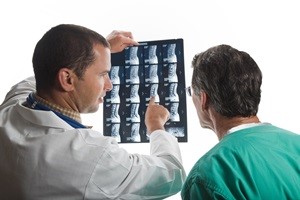What Is Nerve Entrapment and How Can It Be Treated?
 Have you ever felt an uncomfortable tingling sensation in your arm after performing the same motion for an extended period of time? Maybe it was after spending a day typing at your computer or raking leaves. This sensation may be caused by nerve entrapment syndrome, a common condition that is sometimes referred to as either a “trapped nerve” or a “pinched nerve”. Nerve entrapment can be uncomfortable, but there are treatments that can relieve the pain and help get you back to feeling normal.
Have you ever felt an uncomfortable tingling sensation in your arm after performing the same motion for an extended period of time? Maybe it was after spending a day typing at your computer or raking leaves. This sensation may be caused by nerve entrapment syndrome, a common condition that is sometimes referred to as either a “trapped nerve” or a “pinched nerve”. Nerve entrapment can be uncomfortable, but there are treatments that can relieve the pain and help get you back to feeling normal.
Your body is equipped with nerves that carry information back and forth between your brain and your limbs, organs, and other body parts. Nerve entrapment happens when a bone, muscle, ligament, tendon, or other tissue presses against one of these nerves. This compression is most likely to occur in response to consistent, repetitive movement. Poor posture, obesity, and previous injury to the affected area are also risk factors.
Symptoms of Nerve Entrapment
The most common symptom of nerve entrapment is discomfort and numbness. You may feel as though a part of your body has “fallen asleep,” or you may find that your grip has weakened. While you may still be able to function normally with these symptoms, you should seek medical attention if the discomfort does not go away on its own after a few days. Sustained compression may lead to chronic pain and permanent nerve damage. This makes for timely intervention crucial to a full recovery.
When you visit your doctor, he or she might use a number of tests to diagnose your condition. After asking you questions about your symptoms and conducting a physical examination, your doctor may order a nerve conduction study. This test uses electrodes to measure electrical impulses in your nerve signals. You might also undergo electromyography (EMG) to evaluate your muscle activity or magnetic resonance imaging (MRI) to determine the root cause of your compression.
Treatment for Nerve Entrapment
Chiropractors in Wilmington NC are experts in diagnosing and treating problems related to the musculoskeletal and nervous systems. There are several types of treatment that have been used successfully to relieve nerve entrapment syndrome:
- Manual therapies, including chiropractic and soft-tissue mobilization.
- Acupuncture.
- Low-level laser therapy (LLLT).
- Transcutaneous electrical nerve stimulation (TENS).
Depending on your specific situation, your chiropractic physician may teach you exercises that will help to stretch and strengthen the muscles around your nerve. He or she may also recommend specific ways to help reduce inflammation around the compressed nerve.
To the extent that nerve entrapment is fundamentally a structural or mechanical issue, the symptoms can often be relieved with rest. Your doctor might instruct you to discontinue the activities that resulted in compression. He or she might also encourage you to wear a splint or brace to keep the problematic area still. If so, don’t be surprised if you are advised to wear your brace overnight. Many people move around while they sleep in ways that can irritate the compressed nerve.
Contact Southeastern Healthcare for Back Pain or Neck Pain Relief in Wilmington NC
If you or someone you care about is experiencing symptoms of nerve entrapment, we encourage you to call Southeastern Healthcare. Call 910-790-3666 to schedule an appointment with one of our chiropractors. We are here for you. With six locations throughout the Wilmington area, we have an office conveniently close to you.
